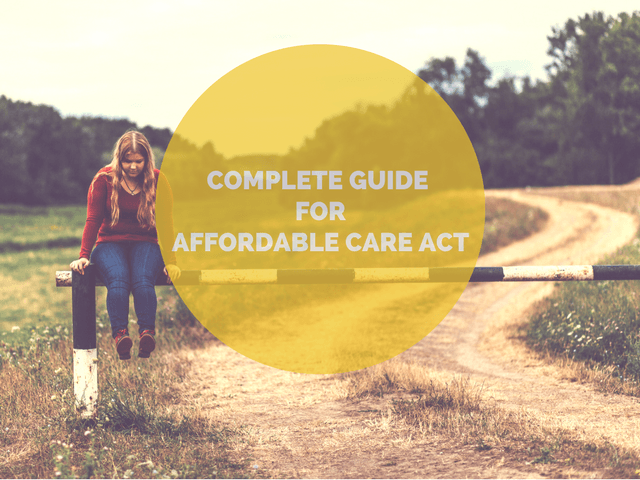What is the Affordable Care Act?
There has been a lot of confusing when it comes to the Affordable Care Act, also known as Obama Care. I’m going to provide you with some essential information about the program and how it works.
ATTENTION: RECENT CHANGES TO TAX LAW HAS AFFECTED THE ACA!
Beginning in 2014, if you were a U.S. citizen or legal resident alien then you and your dependents were required to have Minimum Essential Health Care Coverage, have a health coverage exemption, or make a Shared Responsibility Payment (penalty or ISRP) with your tax return under the Affordable Care Act.
That has now changed! You will not be penalized for lack of health care coverage.
THIS POST MAY CONTAIN AFFILIATE LINKS. PLEASE READ MY DISCLOSURE FOR MORE INFO. Which means if you click on any of the links, I’ll receive a small commission.
Affordable Care Act Summary
The Affordable Care Act (ACA) breaks down into 2 separate pieces of legislation.
-
- The Patient Protection and Affordable Care Act
- The Health Care and Education Act of 2010
ACA as a whole, contains comprehensive health reform and includes tax provisions that affect individuals, families, insurers, employers, and government entities.
Health Care Marketplace
The Health Insurance Marketplaces (also known as Exchanges) are websites available to consumers like you to purchase qualified health plans from different companies. In the Marketplace, plans are available in 5 categories. They differ based on how you and the plan share the cost of medical costs, not on the coverage received.
Each level has an actuarial value – a percentage of the total average cost for benefits the plan will cover.
The 5 categories and their actuarial values are:
-
- Bronze (60%)
-
- Silver (70%)
-
- Gold (80%)
-
- Platinum (90%)
- Catastrophic (only for people under age 30 or with hardship exemptions)

Health Insurance Premium Tax Credit
If you receive health insurance coverage through the Marketplace, then you might be eligible for a premium tax credit.
The premium tax credit is a refundable credit intended to help you if your income is low or moderate in order to pay the health insurance premiums. The credit can be paid in advance to your insurance company to lower monthly premiums or can be claimed on your tax return.
If the advance payment is selected, the amount paid in advance will be reconciled on the tax return.
To be eligible for the premium tax credit, you must meet all of the following requirements:
-
- Health insurance must be purchased through the Health Insurance Marketplace.
-
- You must not be eligible for coverage through an eligible employer or government plan.
-
- Your income must be within certain limits.
-
- You must not file as Married Filing Separately.
- You cannot be claimed as the dependent of another.
If you are eligible for the Premium Tax Credit, you can choose to either:
-
- Get the credit paid in advance directly to your insurance company.
- Wait to get the credit when you file your tax return.

The amount of the credit determined during enrollment at the Marketplace is a projected amount. The actual amount and the credit will be calculated on the tax return.
If the amount paid in advance was too much, the difference will increase the amount you owe and your refund might be reduced or result in a balance due. If the credit is not paid in advance, it will still be calculated on the tax return and the credit will increase your tax refund or lower the balance due.
Note: Any individual who receives the Premium Tax Credit must file a federal return.
Individual Shared Responsibility Payment
The ACA calls for each individual to have minimum essential health coverage, qualify for an exemption, or make a payment when filing your tax return. This provision went into effect January 1, 2014, and applies to individuals of all ages, including children.
Plans that qualify as minimum essential coverage include (but are not limited to):
-
- Any Marketplace plan or any individual insurance plan already in place.
-
- Any employer plan (including COBRA), with or without “grandfathered” status. This includes retiree plans.
-
- Medicare
-
- Medicaid
-
- The Children’s Health Insurance Program
-
- TRICARE (for current service members and military retirees, their families, and survivors)
-
- Veterans’ health care programs (including the Veterans Health Care Program, VA Civilian Health and Medical Program, and Spina Bifida Health Care Benefits Program).
- Peace Corps Volunteer plans
Individual Shared Responsibility Payment Exemptions
There are certain situations where you may be exempt from making shared responsibility payments. You may not be required to make the individual responsibility payment if not covered by minimum essential coverage.
You might qualify for an exemption if:
-
- Uninsured for less than three months of the year
-
- Income falls below the threshold required to file a federal tax return
-
- Incarcerated and not being held pending disposition of charges
-
- Coverage available is not affordable (annual premiums are more than 8% of household income)
-
- Member of recognized health care sharing ministry
-
- A part of a federally recognized tribe or eligible for services through an Indian Health Services provider
-
- Member of a recognized religious sect with religious objections to insurance including Social Security and Medicare
- Not lawfully present in the United States

Individual Shared Responsibility Payment Hardship Exemptions
Some reasons you could request a hardship exemption are:
-
- Homelessness
-
- Eviction in the past six months or faced eviction or foreclosure
-
- Received a shut-off notice from a utility company
-
- Death of a close family member
-
- Flood, fire, or other disaster that caused substantial damage to his or her property
-
- Bankruptcy filed in the past six months
-
- Substantial debt due to unpaid medical expenses in the last 24 months
-
- Unexpected increase in necessary expenses due to caring for an ill, disabled, or aging family member
-
- Dependent child was denied coverage in Medicaid and CHIP and another person is required by court order to provide medical support for the child
-
- Eligibility for enrollment in a qualified health plan through the marketplace only after an eligibility appeals decision that lowers costs on monthly premiums or cost-sharing reductions for a time period when not enrolled in a plan through the Marketplace
-
- Ineligibility for Medicaid because the taxpayer’s state did not expand Medicaid under the ACA
- Insurance plan cancelled by the insurance company and no affordable plans are available in the Marketplace
Individual Shared Responsibility Payment Amount
If you do not maintain minimum essential coverage and do not qualify for an exemption, you must pay the individual shared responsibility payment with your tax return.
For 2017, the individual shared responsibility payment is the greater of:
-
- 2.5% of household income that is above the tax return threshold for the filing status, or
- Flat dollar amount of $695 per adult and $347.50 per child limited to a maximum of $2,085
The payment is capped at the cost of the national average premium for a Bronze-level health plan available through the Marketplace in 2017.
Note: For tax year 2017 and beyond, the percentage amount will remain at 2.5%, but the flat fee will be adjusted for inflation.
Common Affordable Care Act Reporting Forms
To monitor compliance with the individual and employer mandates, the ACA requires reporting by employers and insurers. These are some typical forms you would receive during tax season, which would help complete your tax return.
Form 1095-A Health Insurance Marketplace Statement
Form 1095-A is furnished by the Marketplace to individuals who enroll in a qualified health plan through the Marketplace. This form helps you reconcile the premium tax credit and file an accurate return.
Form 1095-B Health Coverage
Form 1095-B is used by insurers and certain employers to report information to the IRS and taxpayers who were covered by minimum essential coverage. The form reports the type of coverage, members of the tax household who were covered, and the period of coverage for the year.
Form 1095-C Employer-Provided Health Insurance Offer and Coverage Insurance
Form 1095-C is filed and furnished to any employee of an Applicable Large Employer (ALE) who is a full-time employee for one or more months. The form reports the coverage offered and coverage accepted from the employer.
An ALE is an employer with at least 50 full-time or full-time equivalent employees. Only ALE’s are required to file Form 1095-C.

I hope this breakdown of the Affordable Care Act helps you out. If you want more handy tax tips, then feel free to check out my latest articles here.
If you enjoyed this article, then you’ll love these:
- Best Rules for Claiming a Dependent on Your Tax Return
- When to Claim Tips on Your Tax Return
- Do I Need to File a Tax Return?
- How to Choose the Best Filing Status
- Top 12 Things You Must Know About the New Tax Law
For more money-saving tips and guides, subscribe to the weekly newsletter!
I’m super grateful when you share my posts on Twitter, Instagram, Facebook, or Pinterest. It helps spread the word about The Handy Tax Guy and allows me to keep bringing you great content.
Until the next money adventure, take care!
Handy

All data and information provided on this site is for informational purposes only. The Handy Tax Guy makes no absolute representation to the correctness, mistakes, omissions, delays, appropriateness, or legitimacy of any information on this site.
**Note: Each client circumstance will vary on a case by case basis**

